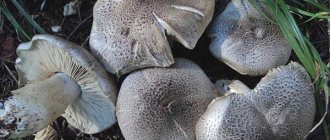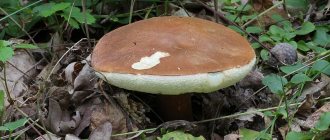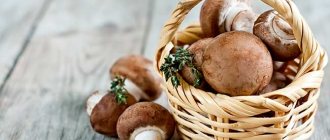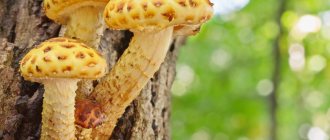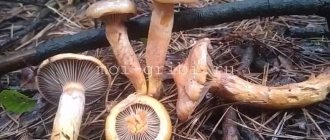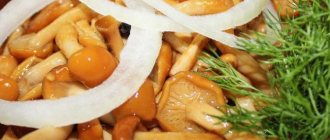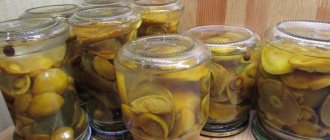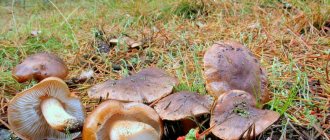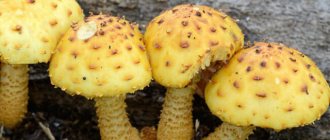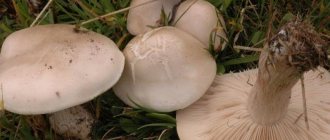May is a great season to try yourself as a mushroom picker. Not many people know that it is in this month that you can find many fruits of such a useful species as the May row. This small fruit is widely used in cooking and contains a lot of useful substances. By getting to know the nature of this plant better, you can discover many new interesting facts.
Description of edible wrinkled mushroom
May mushroom is not the only name of the forest gift of nature. It has both many popular nicknames - St. George's mushroom, May row or simply Mike, and scientific names - Calocybe gambosa, indicating its belonging to the genus Calocybe. In biological taxonomy, the May mushroom belongs to the class of Agaricomycetes and the Lyophyllaceae family. From the name that people gave to this fruiting body, it is clear that it is ready for harvest in the last month of spring.
Externally, the T-shirt is not very noticeable: gray-white color, medium size, small hat. It resembles russula and has no special distinctive features. You can recognize this mushroom by the smell it emits when the cap is damaged (reminiscent of ground flour).
The disadvantage for lovers of quiet hunting is that the May mushroom is very susceptible to spoilage. Worms, insects, and caterpillars often destroy it both outside and inside. To check the fruit, it is not enough to examine it; unfortunately, you will have to violate its integrity by cutting it.
hat
Mushrooms appear with a light beige cap that looks like a hemisphere. As it ripens, it straightens, and the color of this part also darkens in overripe mushrooms; it can become ocher. The maximum size is 10–12 cm in diameter. Smooth and dry to the touch. In hot and dry weather, cracks form on the cap and the shape becomes slightly deformed.
This happens due to group growth, mushrooms can be very close to each other, and sometimes there is simply not enough space for the caps.
Hymenophore
The hymenophore is an adherent plastic of beige, almost white color, sometimes they even grow with a tooth. This is the part of the mushroom located on the back of the cap that bears spores.
Pulp on the cut
The flesh of the May row itself is white, but it is worth knowing the peculiarity of the closest inedible relatives of this species. For example, a mushroom with a similar name “Ryadovka white” is inedible; you can distinguish them from the May row: if you break or cut the flesh, in a poisonous mushroom it will turn pink, but in a T-shirt it will remain light.
Leg
The leg is a small, uneven cylinder that can expand or contract. Color varies from white to cream and yellow as it ripens. May have a reddish-brown tint. Leg length - from 3–9 cm.
Interesting facts about rowing
- Gray row
. The cap is gray, convex at first, then with a flattened tubercle in the middle, the plates are tightly set, milky white. Additional names: pine pine, streaked, green grass, poplar. - Lilac-legged
. The cap is white, but the leg has a lilac tint, the cap is smooth, flat or curved. Common names: blueleg, two-color, blue root. “Disguised” as honey fungus. - Earthy or ground row
. Gray cap in the shape of a cone, sparse plates, hollow stem. It grows only in coniferous forests, including the Caucasus. - Mongolian young rower
. It is similar in appearance to a porcini mushroom and differs only in the reverse side of the cap - it has frequent white plates. In an old mushroom, the cap becomes brown and flattened, the edges bend upward. In Mongolia, it is widely used for medicinal purposes in treating infectious diseases and lowering blood sugar levels. - Japanese pine mushroom or matsutake
. Valued for its taste. The caps are light to dark brown; in older mushrooms they crack. The leg has brown spots and a white collar on top; the bottom of the leg is completely brown. The popular names in Russia are shod or spotted. This mushroom is one of the most expensive; dishes made from it belong to haute cuisine. - Giant row
. Outwardly, it does not look like a lamellar mushroom, the diameter of the cap is up to 20 cm, the edges of the young mushroom are tightly pressed to the thick stem, the old mushroom has a cap with raised edges. It grows in Japan and... in Africa. The plates are wide, white, and when broken, the flesh of the mushrooms turns red. - The row is yellow-brown
. Smooth light brown color, with light yellow plates. Unlike the above mushrooms, the taste is bitter. It grows only under birch trees. - Crowded row
. It grows in colonies, has low edible quality, and is not popular among mushroom pickers. The color of the cap is off-white to light brown, the legs are light, straight or swollen. - May row
. Light beige cap, whitish with yellowish stem. The pulp is fleshy, the plates are first white and then light yellow. The taste is floury. - Poplar row
. The convex, fleshy, glossy brown cap expands as it ripens; the flesh under the skin is pinkish; in older mushrooms it darkens. The mushroom is conditionally edible. - Purple row
. Other names are blueleg, cyanosis, titmouse. The hemispherical cap of a mature mushroom bends inward, the purple flesh gradually becomes yellowish. The plates are also purple, the leg is light. - The row is open-shaped
. Visually similar to honey fungus, as the name suggests. The cap is yellowish-brown, the plates are pale pink.
Poisonous “individuals” of this species include:
- Ryadovka white or stinking - a white mushroom when young and with brown spots when mature;
- Soapy - no toxic properties, but when cooked it tastes like soap, so it is not popular among mushroom pickers, the cap is olive, the leg is dotted with red spots;
- Sulphurous, sulphurous, sulfur-yellow - the cap is yellowish, with a hole in the middle, emits the smell of hydrogen sulfide when broken;
- Pointed, mousey, striped - dark gray color of the whole mushroom, the flesh has a burning taste;
- Tiger or leopard - a wide cap with brown spots, curved edges, gray flesh.
Time and place of fruiting
You can start collecting May mushroom in the second half of April and until the beginning of summer. The rows form heaped groups, but can be found individually and in the form of “witch rings.” Its prevalence is extensive and does not have a specific sign, the main thing is that the sun hits: the edge of a forest (coniferous or deciduous), short grass, country roads, the outskirts of fields.
Summer residents can also find a T-shirt in their garden or garden.
In the Crimea, which is popular for lovers of quiet hunting, it can be found in humus soils, in thickets, in the forest it likes to breed on limestone and in old, almost rotten foliage. Not tied to a specific tree species, like many species.
Inedible types of rows
Pseudowhite (Tricholoma pseudoalbum)
- Lives alone or in small groups in mixed or deciduous forests.
- Grows from August to October.
- The cap is hemispherical at the beginning of growth, later it becomes convex, reaches a diameter of 3-8 cm. Its color is white, cream or slightly pinkish.
- The leg grows up to 3-9 cm in height and 1.5 cm in width. It is the same shade as the cap: white, pinkish or creamy white.
- The pulp has a mealy odor, is white at first, then slightly yellowish.
- The plates are cream-colored, at first slightly grown in, and then almost free.
- It has an unpleasant taste, so it is not eaten.
This species is similar in shape and size to Mayweed (Tricholoma gambosa). But the latter has greenish or soft pink areas on the cap.
Stinky (Tricholoma inamoenum)
- Grows in groups or singly in humid areas of deciduous or mixed forests.
- The growing season is from June to October.
- The cap usually reaches 3-8 cm in diameter, but can grow up to 15 cm. Its surface is smooth, often lumpy, ivory or white, and as it grows, brownish or yellowish spots appear. At the beginning of growth, the cap has a hemispherical shape, and with age it becomes convexly spread, with slightly wavy edges.
- The length of the leg grows up to 5-15 cm, and the thickness up to 2 cm. It has a cylindrical shape, elastic and dense, the color is identical to the cap.
- The white flesh is fleshy and dense. Representatives of this species are distinguished by a strong stinking odor, which is characteristic of both young and old mushrooms. The smell is similar to lamp gas.
- The adherent plates of medium frequency can be white or cream in color.
- Due to the stench, these mushrooms are not edible. Even cooking does not eliminate it.
Often, at the beginning of growth, you can confuse the stinking row with edible sulfur (Tricholoma portentosum). But it lives up to its name and the stinky smell is hard to miss. And the gray row has a pleasant mushroom aroma.
Similar toadstool mushrooms and dangerous poisonous counterparts
Due to their simple appearance, May rows have many similar dangerous doubles. It’s not scary if you confuse the row with a champignon; it’s much worse to make a mistake in favor of the white row, sulfur row, pointed, tiger row, or toadstool.
First of all, you need to understand that it is impossible to find a May row later than May, so you shouldn’t be happy that you collected a T-shirt for your table in July - August, obviously, this is a harmful double.
If an inexperienced forest lover goes in search of St. George's mushroom, it would be useful to take a cheat sheet to distinguish a real T-shirt from a similar mushroom.
| Type of mushroom External differences | May row | Ryadovka sulfurous | Ryadovka white | Ryadovka pointed | Ryadovka brindle | Toadstool |
| Coloring | White-beige | Gray-yellow | gray-white, yellow-brown with brown spots | Dark grey | Off-white, Black-gray | Grayish olive |
| hat | First convex, then flat | Convex, over time a hole remains in the middle | First convex, then prostrate | First, a bell-shaped cone, then flat-convex with a tubercle in the middle | First a ball, then a bell covered with scales | In film, both flat and domed |
| Hymenophore | Frequent, fleshy plates | Rare records | Turns pink when cut | The plates are frequent, uneven | Yellowish sparse plates; pulp is gray | The plates are white, loose, wide |
| Smell | flour | Hydrogen sulfide, tar, | Harsh, unpleasant | Without smell | Flour, without buckwheat | Not expressed |
| Fruiting season | May | Mid-August - October | August - October | September - November | Aug. Sept | Mid-August-September |
| Place of distribution | Any forests and forest plantations | Deciduous, mixed forests of European territory | Deciduous forests with birch | Coniferous forests, prefers pine and larch | Coniferous, deciduous forests, bear fruit singly | In places with high humidity and temperate climates |
For greater clarity, the poisonous twins of the May row can be compared using the photographs in the table.
Photos of harvest 2022:
May row is one of the popular edible mushrooms in Russia, Belarus and Ukraine. The fruits sprout in almost all green areas where trees and shrubs are planted. You can find the fruits from mid-May to mid-late June, going in search after heavy rain.
Evaluation of taste qualities, medicinal properties, benefits and possible harm
St. George's mushroom belongs to the edible mushrooms of the last, fourth category. It cannot be said that everyone will like its smell and taste, but the May row has fans. When fresh, the smell is reminiscent of flour, some pick up notes of cucumber or herbs, but it mostly disappears during cooking.
After heat treatment, a sweetish soft mushroom taste remains.
It is noteworthy that this little-known and inconspicuous fungus with low taste qualities gives a person a huge amount of vitamins, valuable microelements and amino acids. It contains substances that can suppress the development of tuberculosis and inflammatory processes.
The miracle mushroom will be useful for diabetics to normalize blood sugar. When eaten regularly, T-shirt can regulate metabolism, strengthen blood vessels and bones, and is also beneficial for brain cells.
Chitin and melanin are substances that help fight chronic fatigue syndrome, diseases of the digestive tract and nervous system. They also stimulate the removal of various toxic substances and heavy metal salts from the body.
A negative reaction to May row is extremely rare, since the species is classified as a harmless, low-allergenic product, but people with gastritis, ulcers, or pancreatitis should still use it carefully so as not to aggravate the disease.
To get the maximum benefit from this mushroom, collection should be done away from roads, factories, and polluted places, since any fruiting body, like a sponge, absorbs harmful substances from the soil and air.
IMPORTANT! Doctors do not recommend eating this mushroom for women during pregnancy and breastfeeding, as well as for preschool children.
Growing
Growing May mushrooms at home is quite simple. Mushroom mycelium is placed in special bags or boxes, which are located in a dark place. To protect from the sun, you can install a special corner roof. The ideal temperature for the development and growth of mycelium is 20 degrees.
After 2 or 3 weeks, the mycelium completely fills the bags. After another 21–25 days, the first mushrooms appear. The optimal temperature for fruiting is 15⁰C. The first harvests come in waves, and then the rows can be harvested continuously. After three to four months, fungal growth stops and the substrate is used on the site as fertilizer. Kalocybe is also grown in specially equipped rooms, maintaining the required temperature and humidity.
The May mushroom is a pleasant gift for any mushroom picker at a time when there are no other mushrooms in the forest. It will please true connoisseurs and gourmets.
Cooking recipes
Even the simplest cooking method will reveal the special taste qualities of the St. George mushroom. Once you are sure that you like it, you can experiment with ingredients in every possible way, use the fruit in baked goods, salads, and sauces. May mushroom is also good when salted and pickled.
Primary processing
The rows usually have severe dirt on the cap and along the entire length of the stem, so you should not ignore the initial treatment before preparing the dish. After it, the specific mealy smell will also go away.
The process itself, in addition to heat treatment, has some tricks. After cleaning from forest debris, the mushrooms are left in water for 2 hours. Next, bring to a boil, drain in a colander and boil in new water with the addition of vinegar for 20 minutes.
To completely eliminate the characteristic smell of the row, you can cook the fruit with the peeled onion for the last 10 minutes. Finally, the processed fruiting bodies are washed under plenty of cold water and drained in a colander.
Cooking
Few people find boiled May row tasty, but if you still want to try this mushroom boiled, you should cook it for 30 minutes after boiling. During the process you need to stir and skim off the foam. The amount of water should be 2 times more than the mushrooms.
The shirt boils down strongly and has a rubber-like structure. When boiled, it can be used in soups.
Pickling
The most popular type of row preparations is pickling.
Ingredients for 2 kg of mushrooms:
- water – 0.5 l;
- table vinegar - 4 tbsp. l.;
- cloves, bay leaves - 3 pcs.;
- sugar – 2 tbsp. l.;
- table salt – 1 tbsp. l.;
- black pepper – 10 peas.
Preparation:
- Boil the rows until tender.
- Mix vinegar, pepper, cloves and bay leaf in water.
- Put on fire and cook for 10 minutes.
- Pour the boiled mixture into sterile containers.
Frying
Frying is a universal and simple way to prepare mushrooms, and rowing is no exception.
Before frying, it is processed and cooked, and then fried in oil until cooked.
Salting method
Salted May rows are a nutritious and low-calorie product. Boil the required amount of mushrooms and dry from excess liquid.
Place horseradish leaves and a few black peppercorns in a sterile container. Then lay out the boiled rows, add salt and crushed garlic. The pickle is ready in 30 days.
Mushrooms in French
Despite the fact that such a delicacy as French mushrooms is usually served from champignons and porcini mushrooms, you can also prepare them from May rows.
Ingredients:
- 100 g smoked brisket;
- 1 glass of dry white wine;
- butter;
- 500 g mushrooms;
- half a lemon;
- grated cheese;
- salt and pepper.
Step-by-step preparation:
- Wash the rows, peel, cut into slices and simmer in a frying pan with the addition of butter.
- Then transfer the mushrooms to a fireproof dish and place thin slices of smoked brisket on top.
- Pour wine and lemon juice over everything, salt and pepper. Place the pan in the oven and bake at medium temperature until done.
- Five minutes before serving, sprinkle with grated cheese.
Preservation for the winter
Preservation for the winter occurs in the form of salting or pickling. The prepared rows are rolled into sterile jars under vacuum.
How to cook properly?
Row mushrooms, only if they are edible, can and even should be eaten. But before you start making a dish with mushrooms, you should first prepare fresh mushrooms.
How to process rows?
It is necessary to first sort out the collected rows and clean them of leaves and grass. Next, the mushrooms should be thoroughly rinsed under running water or soaked in water for several hours (this is done when the mushrooms are too dirty). Then pour clean water into the container, add vinegar and bring to a boil. As soon as the liquid begins to boil, place the washed mushrooms in a saucepan and boil for about ten minutes. Then the broth must be drained, and the rows must be filled with water again, adding vinegar, and boiled for about twenty minutes. Then put the peeled onions into the container and cook for another ten minutes (this is necessary so that the mushrooms do not emit a powdery smell). When the mushrooms are cooked, they need to be thrown into a colander, and then proceed to further preparation of the dish.
How to prepare rows so that they don’t taste bitter?
To get rid of the bitter taste, you should remove the skin from the cap during processing, soak the mushrooms in salted water (a kilogram of rows requires thirty grams of salt and a liter of water) for a day (the longer the mushrooms are soaked, the better the bitterness comes out of the pulp) or during While cooking the mushrooms, add a peeled onion to the broth (this method was described above).
How to cook rows?
Process a kilogram of fresh mushrooms as indicated above. Next, pour a liter of water into a deep container, add thirty grams of salt, a pinch of citric acid and boil. When the liquid begins to boil, place the cleaned rows into the container and boil for about twenty minutes under a closed lid. After ten minutes of cooking, add a couple of clove buds, six peppercorns and bay leaves to the mushrooms. After twenty minutes, transfer the boiled mushrooms to a colander - and you can begin further preparing the dish.
How to fry rows?
Peel, rinse and place approximately five hundred grams of fresh mushrooms in a deep container, adding two liters of water and thirty grams of salt. Boil the mixture and simmer for about twenty minutes (you should constantly skim off the foam). Place the boiled rows in a colander to drain excess liquid, and then place in a heated frying pan coated with vegetable oil. Fry the mushrooms for about ten minutes, stirring regularly.
How to pickle rows at home?
You will need a kilogram of fresh rows, which need to be cleaned, washed and cut. Then the mushrooms should be boiled as indicated above. At the end of cooking, mix the row with forty-five milliliters of vinegar and distribute into a sterilized container, adding thirty-five grams of sugar, five peppercorns, four buds of cloves and a couple of bay leaves. Afterwards, the jars should be sealed tightly.
How to salt rows for the winter? Boil a kilogram of mushrooms and transfer to a colander to remove all the liquid. Next, put three leaves of horseradish, ten peppercorns into a sterilized container, and then lay out the boiled rows in layers, sprinkling each layer with salt and adding three chopped cloves of garlic. In forty-two days, the salted mushrooms will be ready for the winter. The shelf life of the product is no more than twelve months.
Video
Sources
- https://edaplus.info/produce/blewits.htmlhttps://progrib.ru/ryadovki/vidy-ryadovok.htmlhttps://griby.org.ua/opisanie-gribov/ryadovki/https://ru.wikipedia. org/wiki/Ryadovkahttps://www.medmoon.ru/wiki/ryadovki_foto_opisanie.html
Video gallery
Video reviews
A selection of videos with descriptions and recipes for preparing mushrooms
Mushroom experts of the Russian Federation TV, about Mushrooms and Plants in Their Own Words, Alexander Deryabin
